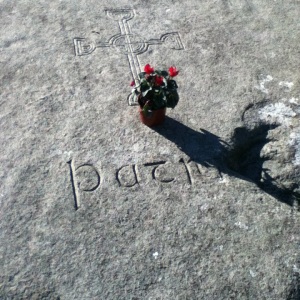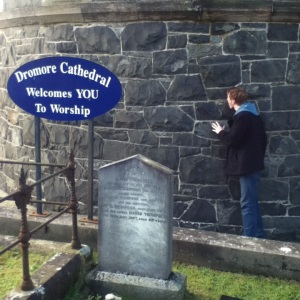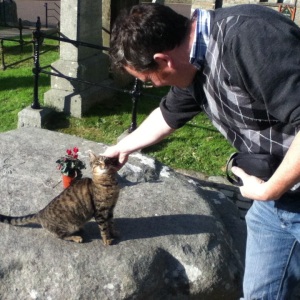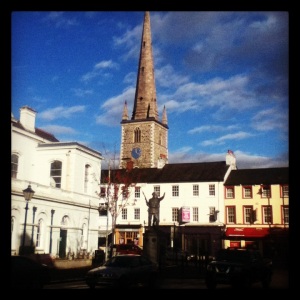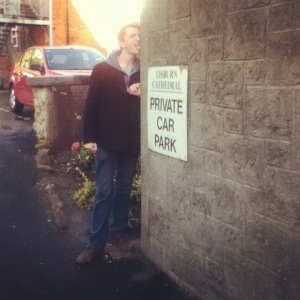With the first Northern Irish cathedral licked at Armagh and a good breakfast inside us we hit the road once more. We had ambitious plans for the day ahead and wanted to get three more done before nightfall, which would be breaking all previous cathedral-licking records. The three triple licking jobs with David had been tiring enough, but this would be a whole new experience.
The next two stops were in across the county border in Down, and on the way an eerie sense of familiarity appeared at every turn. It wasn’t just the fact that all the road signs were British, but also the rolling countryside, which at times resembled Yorkshire in all its greenery and earthy character. It was disorientating to say the least, like an old friend who has changed their name. Instead of signs for Harrogate, Whitby and Leeds we encountered Ballynabragget, Tandragee and the curiously-named Blackskull.
Our first stop, Dromore Cathedral, was a great surprise. When thinking of cathedral cities the tendency is to picture great beasts of churches dominating the view for miles around, in the way that the likes of Lincoln and Durham do so impressively. Their overbearing Norman aura leaves you in no doubt that they were meant to be seen. At Dromore it is a different story, so much so that we actually had trouble locating the cathedral and drove past it several times before realising that the modest-looking church by the River Lagan was in fact our intended goal. It seemed strange to think that this unassuming little building was a member of the cathedral club, but the signs outside confirmed its identity.
By the entrance we found a fine, ancient cross of stone, just one of many we would see on our journey. The sight of it gave me the feeling that Irish Christianity is as old as the stones themselves, and Dromore and its various cathedrals have certainly witnessed a great deal since St. Colman first put wattle to daub here early in the 6th-century. Since these early beginnings the building has gone through several makeovers thanks to a series of destructive mobs and battles nearby. The Normans were once such mob and it was they that saw fit to knock up a castle in Dromore during the 13th-century, which helped to hold the Irish population here under their sway, much like they had done in England 200 years previously. All that remains of their once formidable fort today is a great cone of grassy earth known locally as “the Mound”, from which unsurpassed views of the town and upper Lagan Valley can be had.
Annoyingly the cathedral doors were locked, leaving us cursing our bad luck. This really was a blow, as the prospect of stepping foot inside every Northern Irish cathedral had been an appealing one. We gave the door a good shake or two, in the hope that a kindly curate would unbolt the locks and welcome us in with a smiling apology, and maybe even a cup of tea and a biscuit. In hindsight we probably looked like two desperate men seeking sanctuary. It was all to no avail and all we could do now was lick the place and continue our journey.
Thankfully we had more luck at out next stop, Downpatrick. This place had irked Christopher somewhat, as it is a difficult place to get to by road, but its connection with Ireland’s famous patron saint drove him on with such zeal that we were within sight of the incredibly spiky cathedral in next to no time.
Downpatrick (from the Irish “Dún Pádraig” meaning “Patrick’s Stronghold”) is the county town of Down. The city oozes history and can boast the last resting place of St. Patrick himself, which can be found next to the cathedral on top of yet another hill. Up this now we huffed and puffed and were eventually met with a splendid sight. Looking at its copious spiky stonework I once again pondered the question of the World’s most dangerous cathedral, in terms of its shape when copied into mini models for sale in gift shops. This had been on my mind ever since Silvio Berlusconi had been attacked with a reconstruction of the viciously pointy Milan cathedral in 2009. Had his assailant chosen to wield Down Cathedral, we agreed, that naughty Italian’s woe would have been far greater.
The cathedral is dedicated to the Holy Trinity and is certainly one of Ireland’s great churches. In true Armagh style it has been destroyed and rebuilt many times over, by a mixture of Vikings, other scallywags and even an earthquake! For great stretches of its history it stood as a ruin remained a venerated and holy site. John Wesley was one of its many admirers and he once preached underneath its crumbling walls in 1778, dubbing it a “noble ruin” in his diary. Indeed, the church here was held in such high esteem that Henry VIII had one of its many destroyers – Lord Leonard Grey, Lord Deputy of Ireland – put to death in 1541. If only we could have done the same to other famous church-smashers throughout history, of which sadly there is a depressingly long list.
Although undoubtedly an attractive building, it is the St. Patrick connection that draws most people here of course, ever since the burial of Ireland’s famous snake-botherer somewhere on Cathedral Hill long ago in the year 461. His exact resting place is a mystery but the presence of such holy bones is still celebrated with a great block of stone inscribed with his name. I spent a memorable few minutes here in the company of an enthusiastic tabby cat, who showed its pleasure at meeting me by sinking its claws deep into my thighs. I tried to explain to it that such behavior was not conducive to peaceful, religious reflection, but obviously it thought otherwise and stuck me again and again.
Inside the cathedral we were met with the booming sound of the organ in full voice, which in a gloomier, less welcoming church such as this would have easily filled us with dread. The interior was light, airy and a pleasure to behold. Hints of its medieval past can be found here and there, but most of the present building shows signs of recent renovation, which is no bad thing. While working in Westminster tourists would often complain to me (why, I do not know) about the ongoing renovation work at the Abbey: “It should have been left as it was” they would parp, seemingly oblivious to the fact that Westminster Abbey is a working church and not actually a museum. While on this subject, one woman even declared pompously that only English people should be allowed within its precincts (!), but that is a tale for another time. No, as lovely as medieval architecture is, it is far better to have a building to worship in and enjoy than a crumbling one that sheds masonry onto your skull.
When we made to leave we experienced an awkward moment. A middle-aged lady walked ahead of us and tried in vain to open the door by pressing on a large silver button marked EXIT on the wall. After several fruitless attempts she turned to us and in a soft English accent chortled “Oh, that’s very Irish, you know!” Unsure at how to react I stood frozen to the spot, watching her go as the door finally yielded to her push. “Very Irish, yes” she tittered as she went on her way, giving me a cheeky wink.
I turned to Christopher looking for support, but he was just as dumbfounded as me. The only other person in sight was a kindly old lady in the cathedral shop, who judging by the redness of her face had heard every word and was a now a highly offended local, ready to defend her national honour with a Down Cathedral letter-opener, or anything else that might do the rude Englishwoman some harm. No doubt she had heard me talking to Christopher in my London-cum-Yorkshire accent and identified me as comrade in arms on these foreign shores. Well honestly! I have rarely been so embarrassed by one of my own.
Soon after we made our own way out and got down to the all important job in hand: the 49th cathedral-lick. The prospect of victory was starting to taste better and better.
Downpatrick looked like a good place to spend some time, with charming winding streets and cosy-looking pubs galore, but we were on a mission and time was ticking. For our next stop we took the road north to Belfast, stopping at the bustling suburb of Lisburn for the next lick. It was now late afternoon and we were both beginning to tire and were slipping into that cruel lethargy that creeps up after time spent on the road. The prospect of a good meal and a few jars of ale in Belfast dulled our wits and it is probably for that reason that I remember very little of our time in Lisburn.
As in Dromore the cathedral was closed, this time because of a funeral going on inside. This made us a little uneasy so we got the job done quickly. Once finished we got chatting to to a young, friendly vicar who presumably was on his way inside to conduct the service. This sad occasion blurred my mind further, so much so that the significance of this particular lick bypassed me entirely. Only when we were heading out of town did it occur to me that a huge milestone had just been reached: 50 cathedrals had now been licked! This realisation made me want to hug Christopher with joy, but he rightly suggested that a pint would be a far better way to show my appreciation, so off to Belfast we headed to celebrate this bizarre achievement.
